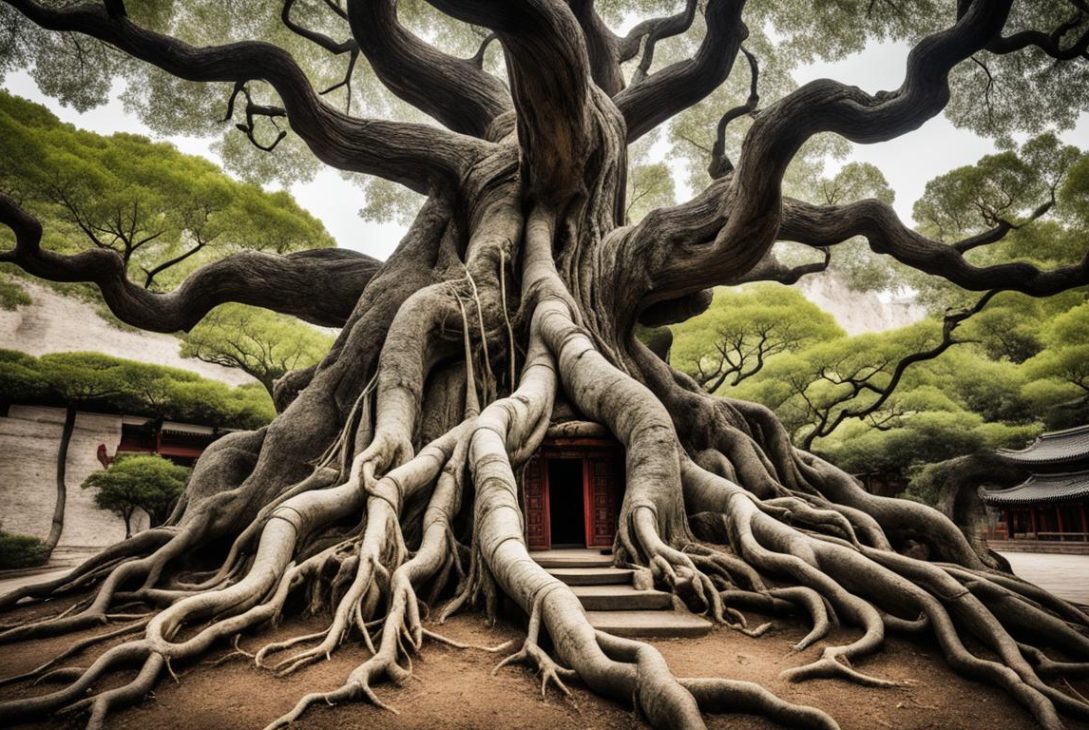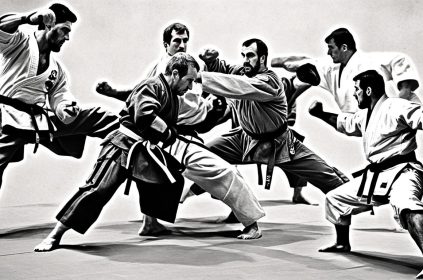The history of Shaolin Kempo is deeply rooted in the ancient traditions of the Shaolin Temple, which was established in China in the 4th century AD. This renowned temple became a hub for martial arts training, attracting warriors and monks alike.
The origins of Shaolin Kempo can be traced back to the 6th century AD, when Bodhidharma, the legendary founder of Chan Buddhism, arrived at the temple. He introduced a new approach to physical training, incorporating techniques that would later evolve into Kempo.
Over the centuries, the Shaolin Temple gave birth to various schools of kung fu, each with its own unique styles and techniques. It wasn’t until the 16th century that the modern system of Kempo emerged, blending the powerful Shaolin fighting techniques with the principles of Jujitsu.
Today, Shaolin Kempo has evolved into a highly respected martial art, known for its devastating strikes, kicks, and joint manipulation techniques. It has been passed down through generations, with various branches preserving the rich lineage established by Professor William Kwai Sun Chow.
Key Takeaways:
Key Takeaways: Exploring the Ancient Shaolin Kempo Techniques and Origins
When it comes to martial arts, the Shaolin Kempo techniques hold a special place. Combining the ancient Shaolin practices with a blend of kempo, this form of self-defense and physical fitness has gained popularity worldwide.
The origins of Shaolin Kempo can be traced back to the legendary Shaolin Monastery, nestled in the mountains of China. This 1500-year-old discipline encompasses various elements such as striking, kicking, grappling, and joint locking. It emphasizes the use of the entire body as a weapon, focusing on fluid movements and precise techniques.
The key takeaway from studying Shaolin Kempo is the understanding that martial arts are not just about combat, but also about personal development. Practitioners learn discipline, mental fortitude, and self-control. The spiritual aspects of this art form often resonate with students, incorporating meditation, breathing exercises, and mental clarity into their training routine.
In conclusion, the ancient Shaolin Kempo techniques have captivated martial arts enthusiasts for centuries. With its origins deeply rooted in the revered Shaolin Monastery, this discipline offers a unique blend of self-defense, physical fitness, and personal growth. Whether one is interested in learning effective techniques, exploring ancient practices, or simply seeking a new form of physical exercise, Shaolin Kempo holds valuable lessons for all.
- Shaolin Kempo traces its origins back to the Shaolin Temple in China.
- Bodhidharma, the founder of Chan Buddhism, introduced the practice of martial arts at the temple.
- Shaolin Kempo combines Shaolin fighting techniques with Jujitsu principles.
- Professor William Kwai Sun Chow played a pivotal role in the development and preservation of Shaolin Kempo.
- Shaolin Kempo is known for its powerful strikes, kicks, and joint manipulation techniques.
The Spread of Shaolin Kempo Across Asia
The Shaolin arts have spread far and wide across Asia, with warriors and dignitaries from various countries seeking training from the Shaolin monks. In turn, many monks have traveled throughout Asia, sharing their unique fighting styles and spreading the influence of Shaolin Kempo.
One of the most renowned centers of Shaolin Kempo practice is the Shaolin Temple in Fukien Province, China. It is here that the birthplace of the five Shaolin animal styles can be found. These styles, which mimic the movements of the Dragon, Tiger, Crane, Leopard, and Snake, have become integral aspects of Shaolin Kempo training.
The training at the Shaolin Temple is known for its rigorous nature, focusing on the development of a healthy body and mind for enlightenment. The monks engage in both empty hand fighting and weapons combat, honing their techniques and discipline.
“The Shaolin arts have transcended borders, captivating and inspiring practitioners throughout Asia. The spreading influence of Shaolin Kempo is a testament to the dedication and skill of the Shaolin warriors and monks.”
Shaolin Kempo’s influence has permeated the martial arts landscape across Asia, making it an integral part of many traditional fighting systems. Its philosophy of discipline, strength, and spiritual development continues to inspire practitioners to this day.
Spread of Shaolin Kempo Across Asia
| Country | Influences |
|---|---|
| Japan | Shorinji Kempo, Nippon Kempo |
| Korea | Hapkido, Taekwondo |
| Thailand | Muay Thai |
| Indonesia | Pencak Silat |
The spread of Shaolin Kempo across Asia has had far-reaching effects on various martial arts styles. From Japan to Korea, Thailand to Indonesia, the influence of Shaolin Kempo can be seen in the techniques and philosophies of different fighting systems. Its impact on the rich tapestry of Asian martial arts is truly remarkable.
The Lineage of Shaolin Kempo
The lineage of Shaolin Kempo can be traced back to Professor William Kwai Sun Chow, a student of James Mitose, the founder of the Kosho-Ryu Kempo style. In 1942, James Mitose opened the Self Defense Club in Hawaii to teach his family’s Kempo, laying the foundation for the art’s growth. It was within this club that William Kwai Sun Chow emerged as a legendary master of Kempo.
As the sole student to master the style, Chow’s influence on Kempo cannot be overstated. His dedication and expertise marked another milestone in the evolution of the art, shaping its path for future generations. Today, various branches of Kempo, including Professor Chow’s system and Ed Parker’s system, continue to be taught and practiced, preserving the rich traditions of Shaolin Kempo.
Professor William Kwai Sun Chow: The Master of Kempo
“Kempo is not merely a method of self-defense; to be effective, it must be practiced as a way of life.”
Professor William Kwai Sun Chow dedicated his life to the art of Kempo. Throughout his career, he emphasized the importance of Kempo as a holistic discipline that extends beyond physical combat. For him, Kempo was a way of life, a practice that cultivated not only self-defense skills but also personal growth, discipline, and mental fortitude.
Chow’s teachings and philosophy continue to shape the way Shaolin Kempo is understood and practiced today. His contributions to the art are celebrated by practitioners worldwide, and his tireless dedication to Kempo’s traditions ensures that the lineage remains intact, passing on the legacy of Shaolin Kempo to future generations.
The Evolution of Shaolin Kempo in the United States
In the United States, the practice of Shaolin Kempo has evolved under the expert guidance of Master Sam Kuoha, who succeeded Professor William Kwai Sun Chow. Shaolin Kempo is a dynamic martial art that incorporates a range of techniques from the ancient Shaolin fighting arts as well as the joint manipulation and grappling techniques of Jujitsu.
Renowned for its devastating kicking and punching techniques, Shaolin Kempo draws inspiration from the movements of powerful animals like the Leopard, Tiger, Crane, Snake, and Dragon. It emphasizes circular movements, speed, conditioning, and the cultivation of strong internal energy.
To give you a taste of the formidable techniques employed in Shaolin Kempo, here are some key elements:
Ancient Shaolin Techniques in Shaolin Kempo
“In Shaolin Kempo, practitioners employ a combination of striking and kicking techniques to overpower their opponents. These techniques have been passed down through generations and have their roots in the ancient practices of the Shaolin fighting arts. The proficiency of Shaolin Kempo practitioners lies not only in the execution of these techniques but also in the underlying principles and philosophy that govern their practice.”
The art of Shaolin Kempo is designed to provide practitioners with a comprehensive self-defense system. By harnessing the essence of the Shaolin fighting arts, practitioners gain proficiency in both striking and kicking techniques, allowing them to adapt to different combat scenarios.
Additionally, the incorporation of joint manipulation and grappling techniques from Jujitsu enhances the versatility of Shaolin Kempo. By emphasizing the understanding of leverage and body mechanics, practitioners can effectively neutralize opponents and gain control in close-quarters situations.
| Key Techniques in Shaolin Kempo | Description |
|---|---|
| Powerful Strikes | Shaolin Kempo practitioners learn to generate immense power and speed in their strikes, delivering devastating blows to their opponents. |
| Dynamism of Kicks | Shaolin Kempo encompasses a wide array of kicks, from lightning-fast strikes to powerful roundhouse kicks, enabling practitioners to keep their opponents at bay. |
| Joint Manipulation | Through intricate manipulations of joints, Shaolin Kempo practitioners are able to immobilize their opponents, rendering them defenseless. |
| Grappling Techniques | Shaolin Kempo incorporates grappling techniques that allow practitioners to control an opponent’s body and neutralize their attacks. |
The training regimen in Shaolin Kempo is rigorous and all-encompassing. It focuses on physical conditioning, mental discipline, and spiritual development. Practitioners undertake strenuous exercises to build strength, flexibility, and endurance. Additionally, meditation and breathing techniques are integrated into the training to cultivate a calm and focused mind.
The Influence of Shaolin Kempo in Other Martial Arts Styles
Shaolin Kempo has had a significant influence on various martial arts styles, showcasing its versatility and effectiveness in combat. The art of Kempo has produced prominent figures who have made notable contributions to the martial arts world.
Kajukenbo: The Fusion of Kempo with Other Disciplines
One of Professor William Kwai Sun Chow’s students, Adriano Emperado, played a pivotal role in establishing Kajukenbo. This martial art combines techniques from Kempo, Karate, Judo, and Tae Kwon Do, resulting in a comprehensive self-defense system that incorporates both striking and grappling techniques. Kajukenbo emphasizes practicality and adaptability, making it an effective style for real-life situations.
Sonny Gascon and the Development of a Branch
Sonny Gascon, a student of Adriano Emperado, further developed another branch of Kempo. Many renowned masters can trace their lineage back to Gascon, highlighting his significant influence in the realm of Kempo. Gascon’s dedication and expertise have left a lasting impact on the art, shaping its growth and evolution.
“Shaolin Kempo has served as a foundation for the creation of new martial arts styles, demonstrating its effectiveness and adaptability in the ever-changing landscape of combat.”
Professor Nick Cerio and the Unification of Kempo Styles
Another influential figure in the world of Kempo was Professor Nick Cerio, a student under George Pesare and Ed Parker. Cerio played a crucial role in bringing different branches of Kempo together, fostering collaboration and knowledge sharing among practitioners. His dedication to the art led to significant advancements and innovations in Kempo training methodologies and techniques.
Shaolin Kempo’s influence on other martial arts styles has been profound, permeating through various disciplines and contributing to their development. Whether it’s the fusion of Kempo with other techniques in Kajukenbo or the unification of different Kempo styles spearheaded by Professor Nick Cerio, the impact of Shaolin Kempo cannot be overlooked.
| Martial Art | Main Influences |
|---|---|
| Kajukenbo | Kempo, Karate, Judo, Tae Kwon Do |
| Sonny Gascon’s Branch of Kempo | Kempo |
| Various Branches of Kempo | Kempo |
Shaolin Kempo’s legacy not only encompasses its own practice but also extends to the broader martial arts community. Through the expertise and innovations of individuals like Adriano Emperado, Sonny Gascon, and Professor Nick Cerio, the influence of Shaolin Kempo continues to shape and enrich the martial arts landscape.
Okinawa and Nippon Kempo
Okinawa and Japan have their own unique variations of Kempo. Okinawa Kenpo is a system of self-defense that originated from the teachings of Master Shigeru Nakamura and has its roots in various Okinawan fighting methods. Nippon Kempo, on the other hand, is a Japanese sport martial art that combines striking, throwing, and ground fighting techniques. Nippon Kempo is known for its full-contact and competitive nature, with practitioners wearing protective gear and utilizing a wide range of techniques in their fights.
Shorinji Kempo
Shorinji Kempo, also known as the Japanese translation of Shaolin Kempo, is a martial art founded by Doshin Sō. After studying martial arts in China, Doshin Sō brought his knowledge back to Japan and developed Shorinji Kempo, incorporating techniques and principles from various styles, including Shaolin Temple Boxing and Quan-Fa.
Shorinji Kempo is renowned for its holistic approach to combat, focusing not only on physical techniques but also on spiritual development. Practitioners of Shorinji Kempo engage in both circular and linear movements, combining grace and power to execute their techniques with precision.
Balancing the Physical and the spiritual
One of the key elements of Shorinji Kempo is its emphasis on balancing the physical and spiritual aspects of martial arts. By incorporating mental and ethical training into their practice, practitioners of Shorinji Kempo strive to develop not only their physical abilities but also their character.
“Shorinji Kempo is not simply about learning how to fight; it is about cultivating one’s inner strength, discipline, and compassion.”
The circular and linear movements in Shorinji Kempo represent the harmonious integration of hard and soft techniques. These movements enable practitioners to adapt to different combat situations, combining power and flexibility to overcome their opponents.
Shorinji Kempo training encompasses a wide range of techniques, including strikes, kicks, throws, joint locks, and grappling. This diverse array of techniques allows practitioners to effectively defend themselves in various scenarios, making Shorinji Kempo a practical and versatile martial art.
Shorinji Kempo Principles and Values
In addition to physical techniques, Shorinji Kempo places a strong emphasis on its guiding principles and values. These principles, known as Kenshi Seishin, guide practitioners in their martial arts journey and in their daily lives:
- Ki: The cultivation of internal energy and mental focus.
- Reigi: Respect for oneself and others, cultivating a sense of humility and courtesy.
- Danketsu: Unity and cooperation, fostering a strong martial arts community.
- Kyu: Constant self-improvement, setting and achieving goals to reach one’s full potential.
- Mikata: Mutual support and protection, helping others and promoting harmony.
These principles not only guide practitioners in their training but also encourage them to apply the values of Shorinji Kempo in their interactions with others, promoting respect, unity, and personal growth.
By incorporating physical techniques, spiritual development, and ethical values, Shorinji Kempo offers a well-rounded martial arts experience. It continues to attract practitioners around the world who appreciate its holistic approach to combat and personal growth.
Conclusion
The history of Shaolin Kempo is deeply rooted in the legendary Shaolin Temple in China, where martial arts training began centuries ago. Influenced by the teachings of Bodhidharma and the ingenuity of Professor William Kwai Sun Chow, Shaolin Kempo has evolved over time, spreading across Asia and leaving its mark on other martial arts styles.
Today, Shaolin Kempo continues to thrive in the United States, with dedicated instructors guiding practitioners on a journey of self-defense, sport, and personal development. The techniques employed in Shaolin Kempo are a testament to its rich origins, combining the wisdom of ancient Shaolin fighting arts with the principles of Jujitsu.
Whether it’s uncovering the history of Shaolin Kempo, exploring its origins, or e
FAQ
What is the history of Shaolin Kempo?
Shaolin Kempo can be traced back to the Shaolin Temple in China, which was built in the 4th century AD. It began in the 6th century AD with the arrival of Bodhidharma and evolved into a comprehensive martial arts training center.
What are the origins of Shaolin Kempo?
The origins of Shaolin Kempo can be traced back to Bodhidharma’s arrival at the Shaolin Temple in the 6th century AD, where he introduced the practice of martial arts in conjunction with Chan Buddhism.
How did Shaolin Kempo evolve over time?
In the 16th century, Kempo was first developed by combining Shaolin fighting techniques with Jujitsu. Since then, various branches of Kempo have been developed and practiced, each with its unique techniques and principles.
Who is considered the founder of modern Shaolin Kempo?
Professor William Kwai Sun Chow is considered the founder of modern Shaolin Kempo. He was a student of James Mitose, the founder of the Kosho-Ryu Kempo style.
What is the lineage of Shaolin Kempo?
The lineage of Shaolin Kempo can be traced back to Professor William Kwai Sun Chow, who was a student of James Mitose. Professor Chow’s system of Kempo marked a significant milestone in the evolution of the art.
How did Shaolin Kempo influence other martial arts styles?
Shaolin Kempo has had a significant influence on other martial arts styles. For example, one of Professor Chow’s students, Adriano Emperado, helped create the art of Kajukenbo, which combines techniques from Kempo, Karate, Judo, and Tae Kwon Do.
What is the significance of Shaolin Kempo in Japan and Okinawa?
Okinawa has its own unique variation of Kempo known as Okinawa Kenpo, while Japan has a martial art called Nippon Kempo. Both styles have their roots in various fighting methods and have evolved into distinctive systems.
What is Shorinji Kempo?
Shorinji Kempo is the Japanese translation of Chinese Shaolin Kempo. It combines techniques and principles from different martial arts styles, focusing on physical techniques and spiritual development.
More information Links
- https://www.villariri.com/history.html
- https://torreypinesmartialarts.com/about-us/the-history-of-shaolin-kempo/
- http://olympickempo.com/about-ikf/kempo-history/
When it comes to understanding the rich heritage and fascinating history of kempo traditions, it’s important to have access to reliable resources and information. Fortunately, there are several websites that offer valuable insights into the shaolin kempo lineage and shaolin martial arts history.
One notable website that sheds light on the subject is villariri.com. Their history page provides extensive details on the origins and evolution of kempo, exploring its roots in the ancient shaolin temples. With a comprehensive overview, readers can gain a deeper understanding of the cultural significance and spiritual aspects associated with this martial art form.
For those seeking a more specific focus on shaolin kempo lineage, torreypinesmartialarts.com is an excellent resource. Their dedicated section on the history of shaolin kempo delves into the contributions of various influential figures and the techniques that have been passed down through generations. This link is a treasure trove for enthusiasts and practitioners looking to trace the martial arts lineage and its impact on their own training.
Another informative website worth visiting is olympickempo.com. Alongside offering a comprehensive overview of the International Kempo Federation, they also highlight the historical roots of kempo. This link provides valuable insights into the diverse influences that have shaped and enriched this martial art form over the centuries, making it an essential resource for anyone interested in understanding the depth and complexity of its history.
In conclusion, the provided links offer valuable and extensive information for those intrigued by the kempo traditions, shaolin kempo lineage, and shaolin martial arts history. Whether you are a practitioner, enthusiast, or simply interested in exploring the cultural and historical aspects, these websites will undoubtedly serve as invaluable resources. So, dive into the depths of the past and enhance your understanding of this fascinating martial art form.
Chinese Martial Arts Kempo Techniques Martial arts history Shaolin Kempo Origins Shaolin Kung Fu Roots Shaolin Temple Influence
Last modified: April 12, 2024




